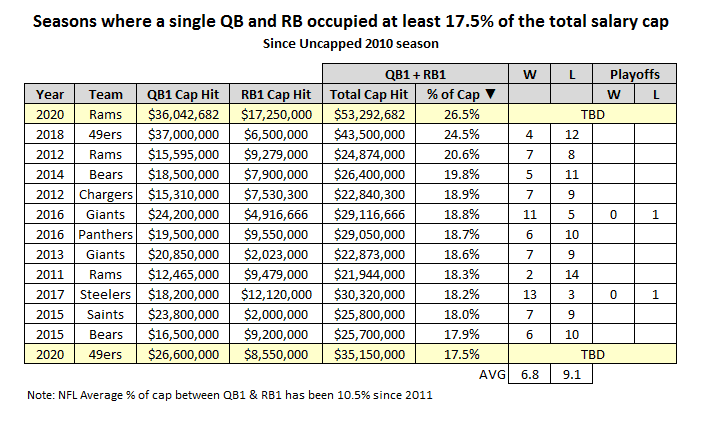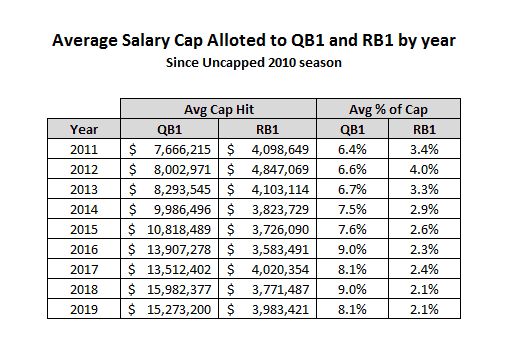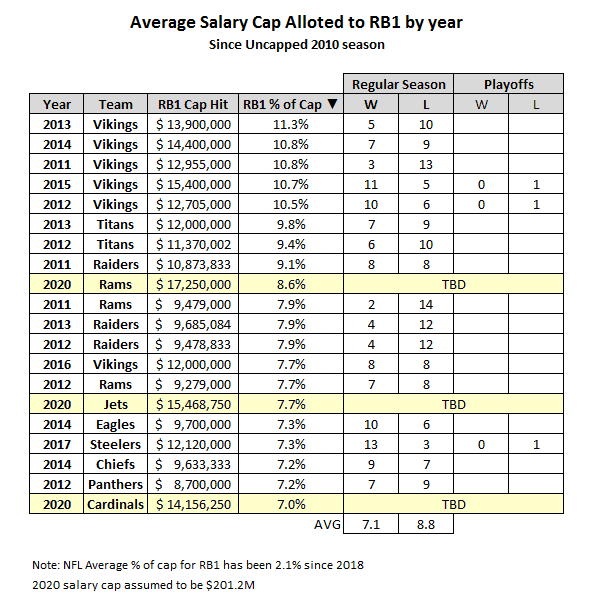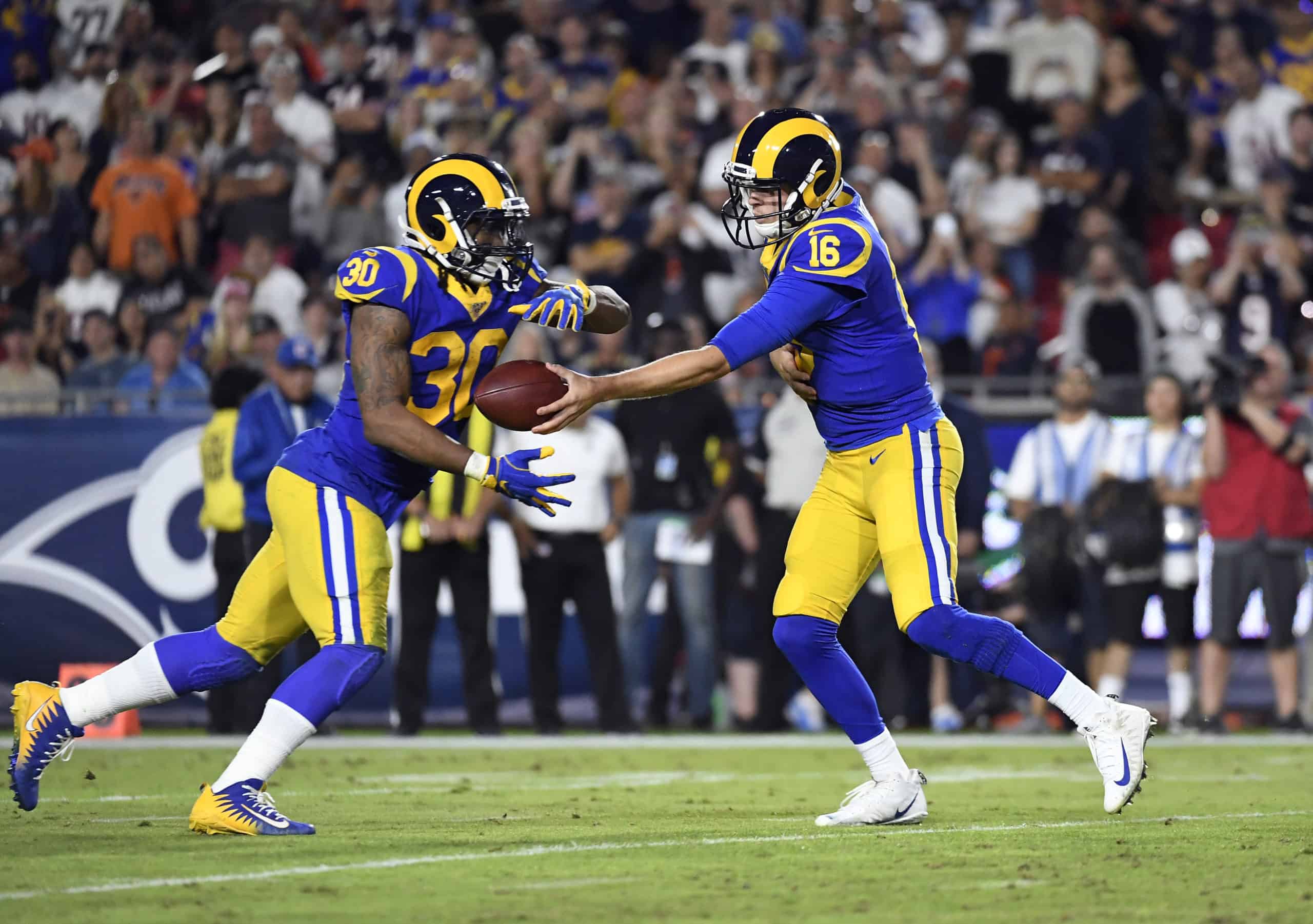Team building in the NFL is an art as much as it is a science. More than any sport, due to the physicality and quantity of participating players (11 offensive, 11 defensive, 11 special teams), building out a 53-man roster capable of withstanding the rigors of competition from July through January is not easy.
If the NFL does expand to 17-game seasons and wear-and-tear increases, the importance of a quality top-to-bottom roster becomes even more critical.
After an uncapped 2010 season, the NFL salary cap increased from $120 million in 2011 to $188.2 million in 2019, with 2020 expected to be between $196.8 million and $201.2 million.
While the cap increased by 57% from 2011 to 2019, many player salaries increased by an even higher rate.
For example, the average QB1 cap hit doubled from 2011 to 2018. As a result, trying to build out a Super Bowl-caliber roster while paying a franchise quarterback has been a challenge for many teams.
Many things have changed since the uncapped 2010 season, including rules which inherently emphasize passing the football as life for quarterbacks and receivers is easier now than it ever has been before.
Thus, paying running backs in the passing era has been even more difficult to manage.
There have been 11 team-seasons since 2011 where a team allocated at least 17.5% of their total salary cap to their QB1 and RB1 (3.8% of their 53-man roster).
Clearly, it’s rare for this to happen.
It’s also rare for this strategy to find success:
- These 11 teams won just over six games on average
- Nine of the 11 teams produced losing records
- Only two of the 11 teams made the playoffs… but each lost their only postseason game

This upcoming season, we will see two teams join those prior 11 in allocating at least 17.5% of their total salary cap to a QB1 and RB1. These two teams are the Los Angeles Rams and the Super Bowl runner-up San Francisco 49ers.
These 2020 teams are also fluid through free agency. Although currently unofficial, the Dallas Cowboys are likely to be a third team in the group, even with a tag of Dak Prescott. With a $10.9 million cap hit for Ezekiel Elliott, Prescott would only need to count for around $25 million on the 2020 cap to hit the 17.5% threshold.
The Tennessee Titans could also make their way into this group with a franchise tag for Ryan Tannehill (or a rumored Tom Brady signing) and a new deal for Derrick Henry.
San Francisco could drop just below the 17.5% with a release of Jerick McKinnon with Tevin Coleman set to count for just under $4.9 million on the cap this season.
The Rams, though, are set to allocate a staggering 26.5% of their entire 2020 salary cap to Jared Goff and Todd Gurley, meaning they will have just 73.5% of the cap to allocate to the other 51 players on their roster.
Also interesting is tracking the average cap hit of a team’s top-paid QB vs a team’s top-paid RB.
While the average cap hit of QB1 doubled from 2011 to 2018, the average cap hit of RB1 decreased from $4.1M to $3.7M.
In fact, as a percentage of cap, in the 2012 season RB1s occupied 4% of the cap on average, but in 2019, that number declined by nearly 50%, down to 2.1%.

As such, it is certainly detrimental for teams that increase the RB pay and percentage of cap hit to well above league averages, considering this position is easier to replace than most and this position’s primary function decreases efficiency as compared to throwing the ball.
It’s rare to see teams allocate substantial amounts of cap space to a single RB.
Since 2011, only 17 team-seasons saw RB1 allocated at least 7% of the cap.
It’s also rare for this strategy to find success:
- These 17 teams won just over seven games on average
- 12 of the 17 teams failed to produce a winning record
- Only three of the 17 teams made the playoffs… but each lost their only postseason game

Over one-third of these team-seasons involve the Vikings and Adrian Peterson in the early 2010s. Removing Peterson, only one of 11 teams made the playoffs (the 2017 Steelers), and the average wins per season remained at seven.
This upcoming season, we will see three teams join those other 17 in allocating at least 7% of their total salary cap to a single RB. Those teams are the Rams, New York Jets, and Arizona Cardinals.
















